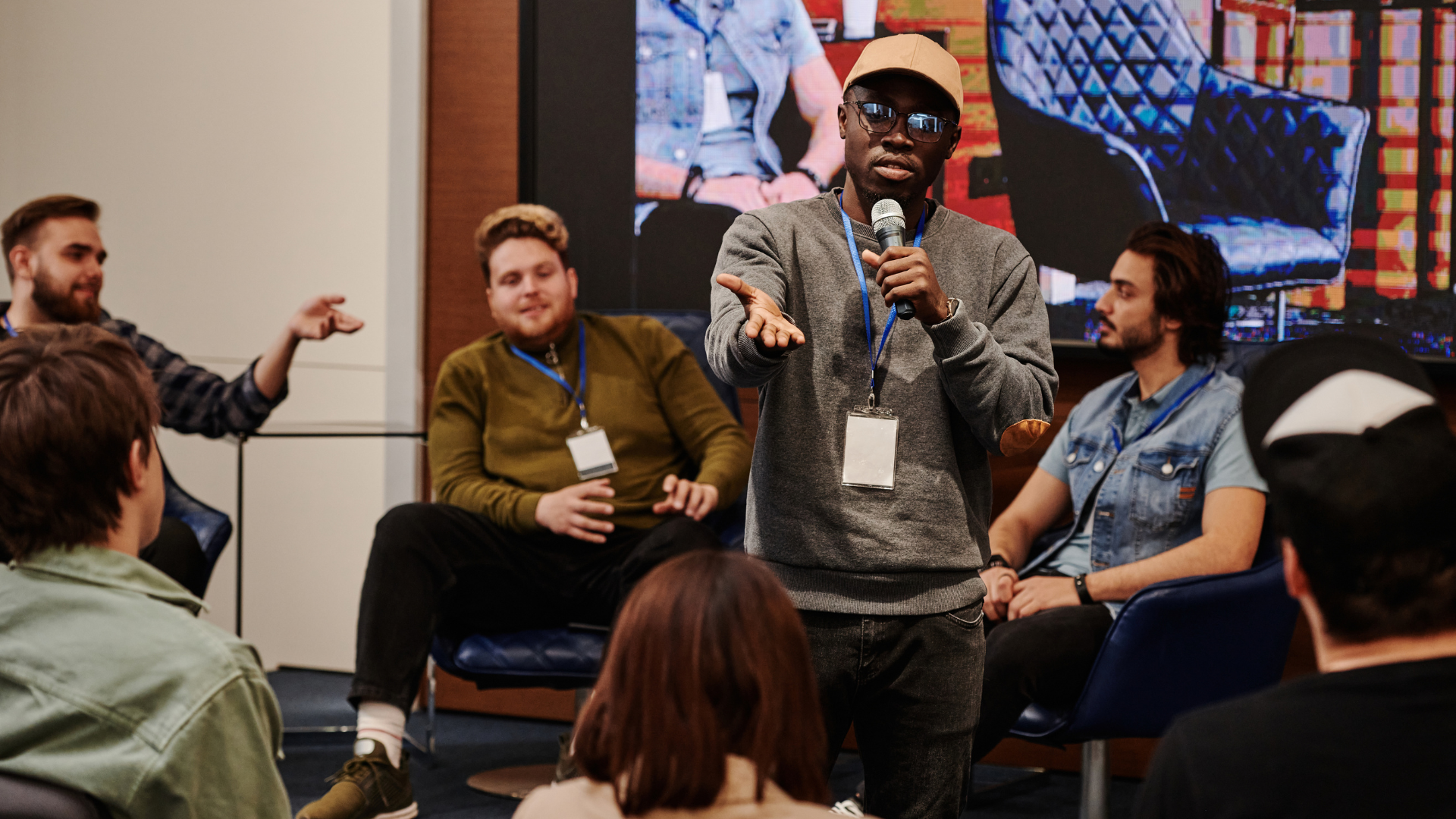Why Even Tech Giants Like Anthropic Need "One Goal, Four Stages"
The AI Paradox: Why Even Tech Giants Like Anthropic Need "One Goal, Four Stages" for Human Communication Skills
The irony is palpable. Anthropic, a leading-edge artificial intelligence company at the forefront of developing sophisticated language models, is explicitly asking job applicants not to use AI in their application materials. Why? Because, in their own words, they want to evaluate "real communication skills."
This seemingly paradoxical situation reveals a profound truth about the modern workplace, and especially within the rapidly evolving AI and tech sectors: human communication skills are not becoming obsolete in the age of AI; they are becoming While AI excels at processing data, generating text, and automating tasks, it cannot replicate the nuanced, empathetic, creative, and truly human aspects of communication that drive collaboration, innovation, and meaningful connection.
And this is precisely where Coach Faisal's "One Goal, Four Stages" framework emerges as an exceptionally pertinent and powerful solution for AI companies, and indeed any organization operating in the complex and often hyper-technical landscape of the 21st century. It's not about replacing technology; it's about humanizing technology by fostering the very human skills that AI, for all its advancements, cannot replicate.
The Communication Skills Gap in the Age of AI: Anthropic's Insight
Anthropic's request is not merely a quirky hiring preference; it's a strategic recognition of a growing communication skills gap, even within organizations pushing the boundaries of AI. Why is this gap so significant, especially in AI companies?
- Over-Reliance on Technical Prowess: AI companies naturally attract and value individuals with deep technical expertise. However, technical brilliance alone is insufficient for team collaboration, cross-functional communication, and translating complex ideas to diverse audiences. Communication skills, often perceived as "soft skills," can be inadvertently undervalued in the pursuit of technical mastery.
- The Need for Nuance and Empathy: AI, while capable of generating text, often lacks genuine nuance, empathy, and the ability to understand the emotional subtext of human communication. AI companies, ironically, need individuals who excel in these uniquely human communication domains to build trust, navigate ethical dilemmas, and connect with users on a human level.
- Complexity of AI and Ethical Considerations: Explaining complex AI concepts to non-technical stakeholders, clients, and the public requires exceptional communication clarity and the ability to build understanding and trust. Furthermore, navigating the ethical implications of AI development demands nuanced and values-driven communication, skills that go far beyond algorithmic proficiency.
- Collaboration in Interdisciplinary Teams: AI development is inherently interdisciplinary, requiring collaboration between engineers, ethicists, designers, business strategists, and more. Effective communication across these diverse teams, with varying backgrounds and perspectives, is paramount for innovation and progress.
- Leadership in the AI Era: Leaders in AI companies need to be more than just technical visionaries; they need to be exceptional communicators – able to inspire teams, articulate complex strategies, build consensus, and foster a culture of open dialogue and continuous learning. https://www.bycoachfaisal.co.uk/coaching
Anthropic's request highlights a critical need: even in the most technologically advanced fields, human-centric communication skills are not just "nice-to-haves" – they are essential capabilities for organizational success, innovation, and ethical responsibility.
"One Goal, Four Stages": The Human Communication Growth Engine for AI Companies
Coach Faisal's "One Goal, Four Stages" framework is ideally positioned to address this communication skills gap within AI companies and tech organizations. It provides a structured, practical, and human-centered approach to developing and enhancing communication skills across the workforce. Let's explore how its core elements directly address the communication challenges highlighted by Anthropic's example:
1. Implicit Learning and Behavioral Priming for Communication Excellence:
- Addressing the Challenge: Technical training often focuses on explicit knowledge and skills. Communication skills, however, are often best developed through practice, experience, and implicit learning.
- "One Goal, Four Stages" Solution: The framework's cyclical nature – repeated monthly engagement with communication-focused goals and stages – leverages implicit learning principles. By consistently practicing communication skills in a structured and supportive environment, employees prime their brains for communication excellence. The four-stage process itself (Awareness, Exploration, Commitment, Integration) becomes a mental template for approaching communication challenges in any context.
- Example Communication Goals for AI Companies:
- "Improve Active Listening in Team Meetings."
- "Practice Clear and Concise Articulation in Technical Explanations."
- "Enhance Empathy in Written and Verbal Communication."
- "Master the Art of Giving and Receiving Constructive Feedback."
2. Cultivating Antifragility in Communication: Thriving in Complex Interactions:
- Addressing the Challenge: The AI field is characterized by rapid change, complex ethical dilemmas, and diverse stakeholder interactions. Communication needs to be resilient and adaptable to navigate this complexity.
- "One Goal, Four Stages" Solution: By engaging with communication-focused goals and navigating the growth stages, employees develop communication antifragility. They become more adaptable in their communication styles, resourceful in handling difficult conversations, and innovative in finding effective communication solutions for diverse audiences and complex situations. The framework, by design, introduces controlled "communication challenges" (through chosen goals and workshop discussions) that, when navigated successfully, strengthen communication capabilities.
- Example Communication Goals for AI Companies:
- "Effectively Communicate Complex AI Concepts to Non-Technical Audiences."
- "Navigate Difficult Conversations and Disagreements Constructively."
- "Adapt Communication Style to Diverse Stakeholder Groups (Engineers, Ethicists, Business Leaders, Public)."
- "Master Cross-Cultural Communication in Global AI Teams."
3. Fostering Micro-Identity Shifts: Seeing Oneself as a Skilled Communicator:
- Addressing the Challenge: Many technically brilliant individuals may not see themselves as "natural communicators." This self-perception can hinder their communication effectiveness and limit their potential impact.
- "One Goal, Four Stages" Solution: The framework fosters micro-identity shifts in employees, helping them to see themselves not just as technical experts, but also as confident, effective communicators. By consistently engaging in communication growth and experiencing progress through the stages, individuals internalize a new self-image as someone who is proactive about communication development, committed to clarity, and part of a company that values effective human interaction.
- Example Communication Goals for AI Companies:
- "Develop Confidence in Public Speaking and Presentations."
- "See Myself as a Highly Effective Written Communicator."
- "Embrace the Identity of a Proactive and Empathetic Communicator."
- "Become Known as a Go-To Person for Clear and Concise Explanations."
4. Unlocking Latent Creativity and Innovation in Communication:
- Addressing the Challenge: Technical communication can sometimes become overly functional and lack creativity or emotional resonance. AI companies need to communicate in ways that are both clear and compelling, inspiring and engaging.
- "One Goal, Four Stages" Solution: By reducing communication stress and fostering a supportive environment for experimentation, the framework unlocks latent creativity and innovation in communication. Employees feel more comfortable trying new communication approaches, exploring different storytelling techniques, and leveraging visual communication to enhance understanding and engagement. Well-being focused goals (e.g., mindfulness, stress reduction) further reduce cognitive load, freeing up mental bandwidth for creative communication strategies.
- Example Communication Goals for AI Companies:
- "Incorporate Storytelling into Technical Presentations to Enhance Engagement."
- "Experiment with Visual Communication Techniques (Infographics, Videos) for Complex Explanations."
- "Develop More Persuasive and Inspiring Communication Styles."
- "Brainstorm Creative Communication Strategies for Different Audiences."
5. Creating a "Narrative of Communication Excellence": Building a Culture of Clarity:
- Addressing the Challenge: In tech companies, the narrative often revolves around technical innovation and engineering prowess. Communication excellence may not be explicitly celebrated or recognized as a core organizational value.
- "One Goal, Four Stages" Solution: The framework organically generates a "narrative of communication excellence" within the organization. As employees share their communication growth journeys, challenges, and successes in workshops and informal interactions, a collective story of valuing clear, empathetic, and effective communication emerges. This narrative reinforces communication as a core organizational value, enhancing internal branding, improving collaboration, and strengthening external communications.
- Example Communication Goals for AI Companies (Organizational Level):
- "Establish a Company-Wide Culture of Clear and Concise Communication."
- "Become Known for Our Empathetic and Human-Centered Communication Style."
- "Build a Narrative of Communication Excellence that Enhances Our Employer Brand."
- "Showcase Employee Communication Success Stories Internally and Externally."
6. Shifting to Intrinsic Motivation for Communication Improvement:
- Addressing the Challenge: Communication training is often perceived as mandatory or remedial, driven by extrinsic pressure rather than intrinsic desire for improvement.
- "One Goal, Four Stages" Solution: The framework fosters a subtle shift towards intrinsic motivation for communication improvement. By focusing on personal growth, celebrating mastery of communication skills, and aligning communication goals with individual values, the program cultivates a genuine appreciation for the art and science of effective human interaction. Employees become motivated to improve their communication not just because it's required, but because they see it as personally rewarding and intrinsically valuable for their professional and personal growth.
- Example Communication Goals for AI Companies:
- "Find Joy and Satisfaction in Mastering Effective Communication Skills."
- "Develop a Lifelong Commitment to Continuous Communication Improvement."
- "Become a Go-To Resource for Communication Mentorship Within the Company."
- "Experience the Intrinsic Rewards of Clear, Empathetic, and Impactful Communication."
Conclusion: Humanizing AI Through Human Communication Growth
Anthropic's explicit request for human-generated application materials is not a rejection of AI; it's a powerful affirmation of the enduring and irreplaceable value of human communication skills, even – and perhaps especially – in the age of artificial intelligence. Coach Faisal's "One Goal, Four Stages" framework offers a timely and highly relevant solution for AI companies and tech organizations seeking to bridge the communication skills gap and cultivate a workforce that is not only technically brilliant but also exceptionally human in its ability to connect, collaborate, and communicate with clarity, empathy, and impact. In a world increasingly shaped by AI, it is the uniquely human skills of communication, nurtured through frameworks like "One Goal, Four Stages," that will ultimately define the success, ethics, and human-centered future of technology. https://www.tiktok.com/@bycoachfaisal









